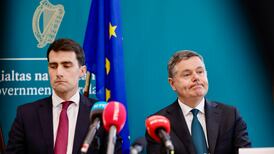SERIOUS MONEY:JOHN KENNETH Galbraith, the late American economist, once quipped that "the function of economic forecasting is to make astrology look respectable".
Celestial bodies certainly proved unkind to the economic bulls on Wall Street in recent weeks, given the relentless flow of data releases that have fallen well short of consensus expectations.
The coup de grace proved to be the publication of the advance estimate of economic growth for the second quarter by the Bureau of Economic Analysis last week, which revealed not only that economic momentum is far weaker than expected, but also that the US economy remains stuck in the recovery phase with activity still running below the level recorded at the previous cycle peak during the latter months of 2007.
But the humbled economist fraternity remains defiant and expects a self-sustaining expansion to take hold any time soon.
The offending gross domestic product data, released by the bureau last Friday, showed that the US economy expanded at an annual rate of just 1.3 per cent during the second quarter, well below the consensus estimate of 1.8 per cent. The disappointment was compounded by the substantial downward revision to first quarter growth from almost 2 per cent to less than half of one percentage point, which means that the world’s largest economy expanded at an annual rate of less than 1 per cent during the first half of the year – more than two percentage points below the pace of advance typical at this stage of the cycle during previous post-second World War expansions.
The report’s details provided little if any reason for optimistic cheer. First, personal consumption expenditures, which account for more than 70 per cent of GDP, registered a negligible increase during the three-month period, as higher unemployment combined with rising food and energy prices weighed on household spending. Second, export growth slowed by almost two percentage points to 6 per cent as global momentum slowed, though the deterioration in net trade was disguised by a collapse in import growth arising from the disruption to global supply chains in Japan.
Finally, government spending declined for the third consecutive quarter as austerity continued to act as a drag on growth.
The data looks even worse when one considers the bureau’s annual revision of the national income and product accounts. The revisions revealed that the peak-to-trough decline in economic activity during the recession was even greater than originally reported – 5.1 per cent versus 4.1 per cent – such that the economy has not yet recovered to pre-recession levels.
Such a development is unprecedented post-second World War. Indeed, excluding the 1980 recovery, which was short-circuited by the 1981-82 recession, the typical up-cycle has generally recovered its prior business peak within three quarters and, by its second anniversary, has exceeded that level by more than 8 per cent. The current up-cycle is the worst in post-second World War history: eight quarters on from the trough and economic activity is no higher today than it was 3½ years ago, while the cumulative GDP increase from the recession’s nadir is less than half that registered during previous recoveries.
It is troubling to note that the year-on-year growth in real GDP has dropped below 2 per cent to just 1.6 per cent. This has happened 12 times since 1950 and on 10 of those occasions the economy was already in recession or soon would be. By itself, such a development would be relatively meaningless, but it is accompanied by a variety of indicators that suggest the recovery has stalled.
First, the yield on 10-year treasuries has dropped to 2.65 per cent, more than 100 basis points below the recent high in early February and a level that is consistent with stagnation in economic activity at best. Second, the spreads on corporate bonds have begun to edge higher, while stock prices have registered a sequence of lower highs since May and are now in retreat. Third, the Institute of Supply Management’s Purchasing Manager Index has dropped from 61.4 in February to 50.9 last month, the lowest level in two years and barely in expansionary territory, though disturbingly, the forward-looking new orders component has already slipped below 50. Fourth, year-on-year employment growth has slipped below 1 per cent, while the jobless rate has resumed its upward march. Finally, consumer confidence remains at recessionary levels, while the spread between future expectations and present conditions has narrowed by more than 10 points to 16 per cent in recent months.
Growth has been painfully slow for the US’s post-crisis economy. And a variety of indicators that have proved to be harbingers of recession in the past have begun to sound the alarm. It is clear the economy has struggled to gain traction despite very low interest rates and quantitative easing, while it is unclear whether a self-sustaining expansion can take hold without further policy assistance.
The economy is stuck in a rut and caution is warranted.
www.charliefell.com









